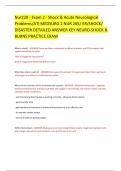Exam (elaborations)
Nur220 - Exam 2 - Shock & Acute Neurological Problems/ATI MEDSURG 2 NUR 265/ ER/SHOCK/ DISASTER DETAILED ANSWER KEY NEURO-SHOCK & BURNS PRACTICE EXAM
- Course
- Institution
Nur220 - Exam 2 - Shock & Acute Neurological Problems/ATI MEDSURG 2 NUR 265/ ER/SHOCK/ DISASTER DETAILED ANSWER KEY NEURO-SHOCK & BURNS PRACTICE EXAM
[Show more]



